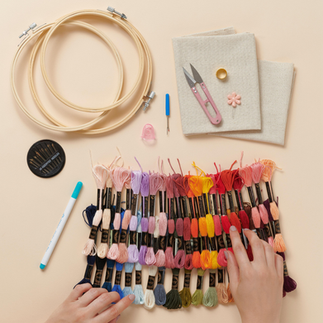5 Embroidery Stitches Explained: Learn the basics of modern embroidery
- Daphne

- Feb 27
- 4 min read
Updated: Mar 7
Do you want to learn how to embroider? Great! I have listed 5 basic embroidery stitches for modern embroidery below and explained them step by step!

The Embroidery Stitches I cover here:
The Running Stitch
The Stem Stitch
The French Knot
The Satin Stitch/Flat Stitch
Lazy daisy stitch
With combinations of these 5 embroidery stitches you can embroider all kinds of embroidery patterns that may look complicated but are actually very simple! Tip; after reading this blog, try to find out which stitch is used where in photos of embroidery. You will soon notice that it is often just different combinations of the named basic stitches and therefore not that difficult at all!
1) The Running Stitch

This is the easiest stitch there is! You pull your needle from front to back through your cloth with exactly the same space between the stitches and that's it. It is the ideal stitch to get the hang of embroidery when you first start. I mainly use it to finish the embroidery hoop, go around the entire embroidery hoop with the running stitch and pull on the 2 protruding strings, the fabric pulls neatly inwards and you can hang up your hoop!
2) The Stem Stitch

I use the stem stitch (surprisingly enough 😉) mainly for embroidering flower stems! It is also a fairly simple stitch once you get the hang of it. In the image next to this text you can see the principle of the stem stitch explained;
You make a stitch, then you take out your needle

back to front halfway through this previous stitch (point 1). You bring this stitch back at point 2, make sure that all stitches are approximately the same length! The longer your stitches, the thinner your stem stitch will be. You keep repeating this principle, at point 3 you see that you put your needle back from behind halfway through the stitch you just made (from point 1 to point 2) and you put this stitch back 1 standard length further at point 4.
3) The French knot

The French knot, also called French knot, is a bit more difficult. With this stitch you make a small knot on your cloth. There is a specific technique for this that I call "the figure eight". You make the shape of a figure 8 with your thread around your needle by making a loop (step 1), pulling your needle through it (step 2). Then you pull your thread around your needle again in the opposite direction, which gives you the figure 8 shape (step 3). Now you pull the thread tight (step 4) and put the needle back to the same place as where you came forward and pull the entire thread through the knot (step 5). Your French knots look like small balls, you can make as many as you want very close together to fill a space. Think of the center of a flower for example!
4) The Satin Stitch/ Flat Stitch

This stitch is a bit easier, all you do is pull stitches from front to back as close together as possible to "color" a surface as it were. In the image next to it you can see how our embroidery fabric consists of very small squares, the secret is to move a square each time you pull the stitches from front to back. Also always pay close attention when embroidering the Flat Stitch in which direction you embroider.

Next to it the stitches are placed vertically but that could also have been horizontal or skewed which would give each a completely different effect! In the image below you see a Daffie's embroidery kit (I make embroidery patterns myself and put together complete beginners kits for that ☺️) where the flat stitch is used very often. It is set up in all kinds of different directions so that you still get a nice pattern with a lot of relief! With the flat stitch you also usually embroider with only 3 yarns of the skein instead of the full 6 because you can work much more precisely that way.

5) The lazy Daisy stitch

The lazy daisy stitch is ideal for embroidering small cute flowers. You can also quickly embroider a large surface with it! You make a loop as large as you want the stitch to be by putting away 2 stitches close to each other, (from point 1 to point 2).

Then you bring your needle back to the front in the very tip of the loop, mind you, still inside the loop! You put your needle back just outside the loop above point 3 (at point 4). In this way you secure the loop, as it were. You can repeat this as often as you want to make a flower like below!
Learning modern embroidery
There are many more embroidery stitches to name within modern embroidery. Think for example of:
The woven wheel
The Backstitch
The Long&short stitch
etc..
You can try out whether modern embroidery is for you with these 5 basic embroidery stitches. Do you want to learn more stitches, have all kinds of handy tips & tricks at hand and immediately start embroidering nice custom beginner friendly patterns? Then you might find the extensive starter manual embroidery useful! This manual can be downloaded as a pdf by following this link: manual modern embroidery
I have put everything in the manual that I found useful when I was just starting out with modern embroidery, hopefully it can get you started right away as well!











Comments